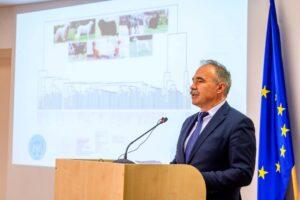Preservation of the gene stock of indigenous breeds is a priority state task
Preserving the gene pool of indigenous plant and animal breeds and maintaining genetic resources is a priority state task – said the Minister of Agriculture on Monday in Budapest, at a press conference presenting the results of the genetic examination of Hungarian dog breeds.

István Nagy, Minister of Agriculture (Photo: Csaba Pelsőczy)
According to István Nagy, in addition to environmental aspects, national security reasons also justify the protection of traditional Hungarian varieties, since it strengthens the independence of agriculture if it is less dependent on foreign propagating material. The Carpathian Basin is one of Europe’s oldest agricultural regions, the diversity of its cultivated plants and farm animals is an outstanding asset, and Hungary, in possession of these, fulfills important gene conservation tasks at the world level. In addition to their economic benefits, indigenous species are also national symbols, but after the Second World War, many of them drifted to the brink of extinction, surviving only in isolation in their original state. The hybrids of industrial animal husbandry mainly pushed the local pig and poultry stocks into the background, but animal species that lost their traditional tasks also suffered significant damage, he emphasized.
Since then, the most endangered have been strengthened with the effective cooperation of state institutions
In 2018, the government adopted a 5-year gene conservation strategy, providing more than HUF 12 billion for the development of gene conservation institutions and the increase of protected stocks. The gene bank network created with state support will help to strengthen traditional breeds even in the event of natural disasters or disease, he said. Dogs are not farm animals, but they cannot be left out of the gene preservation strategy, as they have been a part of the landscape and way of life here since ancient times, and they played a big role in the fact that Hungarians were able to make the Carpathian Basin their home, emphasized the minister, who noted, that the 20th century did not spare these species either, so some stocks still need urgent augmentation. Barely 3,000 dogs have a breeding license, despite the fact that since 2021, breeders of Hungarian breeds can apply for HUF 7,000 subsidies per dog for pedigree registration. The ecological richness of the Carpathian Basin contributes to Hungary’s cultural and financial well-being, which is why the Ministry of Agriculture initiated the promotion of Hungarian dog breeds and the mapping of their genetic background, so that they can continue to exist for the benefit and pleasure of posterity – added István Nagy.
The Association of Hungarian Breeders’ National Association (MEOESZ) has received HUF 50 million annually since the beginning of the program in 2019 for tasks related to the program
The interest group organized the collection of the blood samples needed for genetic testing, so the scientific research could begin, said the president of the organization. Based on the test results, Gábor Korózs emphasized that the gene stock of Hungarian breeds is healthy, none of them are affected by genetic diseases. After collecting the blood samples, the geneticists determined the order of the 4 DNA bases of each breed, i.e. they were the first in the world to compile the genomes of the Hungarian dog breeds – said the research leader of the gene preservation project. Gábor Kovács added that by the end of 2023, the panel containing breed characteristics could be created and put on the market, on the basis of which the breed identity test of dogs of unknown origin can be carried out with great certainty.
The donation collected at an event in February to support search and rescue dog organizations was also presented at the event.
The MEOESZ also contributed to the amount. László Balázs, the president of the Pest County Search and Rescue Service, said that the lives of 17 people were saved in Turkey after the February earthquake. The 4 rescue dogs found close relatives under the ruins, so families can thank them for being together again, he added.
MTI
Related news
AM: Government helps farmers with a loan moratorium
🎧 Hallgasd a cikket: Lejátszás Szünet Folytatás Leállítás Nyelv: Auto…
Read more >More than 100 Hungarian farmers also demonstrated in Brussels
🎧 Hallgasd a cikket: Lejátszás Szünet Folytatás Leállítás Nyelv: Auto…
Read more >NAK: Domestic producers await customers with an ample supply of all pine species
🎧 Hallgasd a cikket: Lejátszás Szünet Folytatás Leállítás Nyelv: Auto…
Read more >Related news
Christmas shock in commerce: for the first time, we can pay with bank cards in fewer places
🎧 Hallgasd a cikket: Lejátszás Szünet Folytatás Leállítás Nyelv: Auto…
Read more >Hungarian Confectionery Manufacturers Association: trends in 2025 and prospects for 2026
🎧 Hallgasd a cikket: Lejátszás Szünet Folytatás Leállítás Nyelv: Auto…
Read more >Most grocery chains will be open until noon on December 24th
🎧 Hallgasd a cikket: Lejátszás Szünet Folytatás Leállítás Nyelv: Auto…
Read more >






